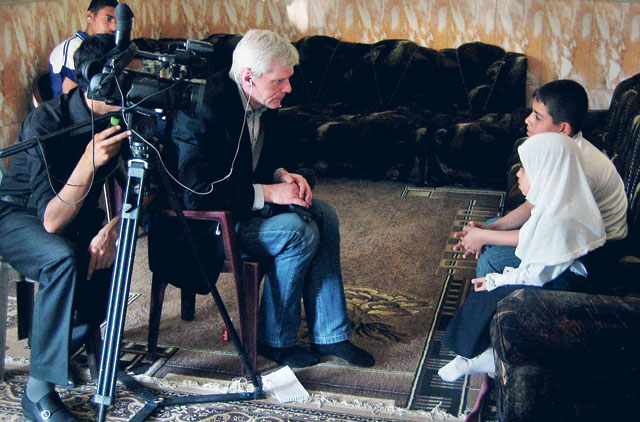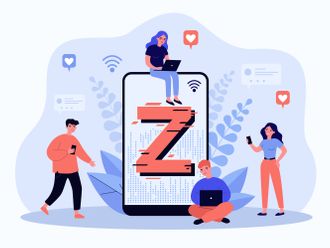
We meet outside the Frontline Club near Paddington station, London.
The man I am here to interview is speaking on his mobile phone as he acknowledges me with a shake of the hand. His name is Kristinn Hrafnsson and he is a journalist from Iceland. The building outside which we are standing was not long ago the venue of an important — some might say historic — press conference by WikiLeaks founder Julian Assange as he faced the world's media the day after the epic leak of 75,000 classified United States documents.
When he finishes the call, we enter the building and head upstairs for the interview. Some of the staff, it becomes apparent, recognise Hrafnsson from his previous visit here. There are not many people around as it is early and we find a table in the corner.
As Hrafnsson begins to talk, choosing his words cautiously at times, it is clear he is touched by the story he has agreed to tell. It all began last winter when he first met the mysterious Assange during the latter's stay in Iceland. The two got to know each other pretty well.
Assange was helping out on a project called the Icelandic Modern Media Initiative, which aims to turn the island nation into a safe haven for whistleblowers and source protection.
"I had interest in his media initiative and also because I knew they had some material that was of special interest to our audience," he says. As a result, Hrafnsson was able to get priority access to material released by WikiLeaks on Icelandic banking and politics.
Then one day an explosive story found its way into his life. "We were sitting in a café in Reykjavik ... Julian had his laptop," says Hrafnsson, as I take a sip from my cup of mint-flavoured tea. "‘Kristinn,' he said, ‘I want to show you something.' And Julian flipped the computer screen over the laptop and played the video. I was sitting with a lot of people around and watching that in total shock. Instantly recognising that this was a massive story, I told him on the spot that I very much wanted to work on a project of releasing it."
The disturbing video recorded attacks in Baghdad by two US Apache helicopters on July 12, 2007, which resulted in the killing of over a dozen Iraqis.
Among the dead were two Reuters employees, photo-journalist Namir Noor Al Deen and his assistant Saeed Chmagh. The driver of a minivan, Saleh Matasher Tomal, is shown in the video stopping to help out Chmagh while he was still alive but injured.
Instead, Tomal finds himself also targeted and killed by the Americans. There is the sound of troops laughing. Tomal's children, who were travelling with him, were also seriously injured. Sayad was 10 and Doaha only 5 years old at the time.
When the US ground troops arrive on the scene and discover the children, one faceless soldier callously remarks: "Well, it's their fault for bringing their children to a battle."
For Hrafnsson, the WikiLeaks video was the biggest story he had ever been involved in during his 20 years as a journalist. But the material was so delicate, he did not even tell his editor at RUV, the Icelandic national broadcaster he was employed with at the time.
So while he worked the next few weeks on the video, verifying all sorts of details, he also had to cover regular news, which included climbing up a volcano that had suddenly begun spewing to get images as he faced blowing snow and poor visibility.
As the date for the leak neared and having watched the video hundreds of times, it was fast turning into an obsession for Hrafnsson to establish the identity of as many people killed or injured in the attack.
With the help of a news organisation already there, he got in contact with a fixer in Baghdad. The fixer turned out to be well acquainted with the district of Al Amin where the incident had taken place and was able to track Tomal's family.
At this point Hrafnsson put forward the idea of getting together a small team and heading off to Baghdad. One week before the leak, he finally told his editor about the video. "Then I put the cards on the table," he tells Weekend Review.
"I said, ‘Well, I want you to put some money front and enter into cooperation with WikiLeaks and sort of co-finance my trip with a cameraman to Baghdad.' There was a bit of ‘Enter into cooperation with WikiLeaks? But they are not a news organisation. Why should we do it? How should we approach it?' And they were a bit cautious about it."
In the end, RUV and WikiLeaks ended up co-financing his trip to Baghdad. "This was reflected similarly in the cooperation between WikiLeaks and The Guardian, The New York Times and Der Spiegel," he says, referring to the three media outlets collaborating on the Afghan war logs.
"They were cautious in their approach and how to actually work with WikiLeaks. But in my opinion, there was never any doubt. I mean, I am a journalist. WikiLeaks is a source of information. I wouldn't take the information from WikiLeaks on a face value. You have to do your own investigation."
To conduct his own investigation, Hrafnsson and his small team arrived in Baghdad early Saturday morning on April 3. As the video was to be leaked to the world two days later, time was of the essence. They met the fixer and drove straight to Al Mansour Hotel to drop their luggage and then headed to the neighbourhood to meet the people. Among those he met from relations of the victims was the family of the minivan driver who was killed.
"I was focusing very much on the family of Matasher Tomal because he was the obvious victim there," he says. The family had received no compensation. Tomal's 32-year-old widow was living with her brother-in-law. She has four children, including the two who were injured in the attack.
The two children wouldn't talk much in front of the strangers. "They just said that they had been fired upon," recalls Hrafnsson. "I didn't want to press them and I don't think it is right to do that in an interview with children. Their dad was killed that day. But they didn't remember much. Both of them [had] passed out. They probably didn't understand what was going on around them that much."
Sayad and Doaha reminded Hrafnsson about his own two children back in Iceland who are about the same age. "My girl is rather small for her age and my boy is rather big for his age," he says.
"And when they were standing there with a picture of their dad — he was a little bit younger than I am — I could identify very much with them, their plight and sorrow. Being at their home there and talking to the people, I felt that this was a bit of a revelation. How much we have overlooked the perspective of the people who have to live through their war, how they were coping with that. Children everywhere all around the world are the same. I mean, my boy likes football and so does Sayad, you know. And the little girl Doaha likes to read as does my daughter."
Hrafnsson questioned the widow and family members of those killed about what had happened. He hadn't at this stage told anyone they were in possession of an actual video of the attack. The account of the incident they related matched closely with what is seen in the video. "I thought at the time that we had been totally ignoring the public," he says.
"Why hadn't anybody done more of simply asking the people? I think it was a failure of the journalists who were working in the field there to jump on the official story. And it entails the attitude that the public can't be trusted overall to tell the truth."
But won't it be dangerous for a Western journalist during wartime to go and talk to ordinary people? "Yes, but journalism should be dangerous," says Hrafnsson. "Journalists are becoming, and have been, a part of the military propaganda machinery — easily manipulated."
On the day the video was to be leaked, Hrafnsson planned to go back to the neighbourhood to monitor the people's reaction. But first he showed the video to his fixer, who reacted with shock and fear, unsure what kind of impact it would have among the people of Al Amin.
He wouldn't let Hrafnsson go back there as he was unsure of the reaction from the people and feared a riot could break out.
Instead the fixer went himself to show the film to the people, taking a camera to record their reaction. "I was a bit shocked when our fixer brought back the video he had shot," says Hrafnsson.
"They allowed the boy Sayad to see it. I was a bit angry that they did it. They knew that it was going to be a devastating thing to see. The family decided that it was okay for him to see it. Possibly they believed that he was now a young man and could take it. It was not right for me to judge sitting there and seeing the expression on his face, watching the attack on the minivan, where his father was killed. He was trying to be brave, trying to be strong."
"It was actually a terribly moving thing," he says. "And I can tell you when I was watching his eyes, you know, and he was actually trembling to keep away the tears. [I felt] I was looking into the eyes of my own son. I could understand what he was going through. And I think I have never been as touched by anything that I have seen. And I thought the sorrow of a child who loses his father is so deep, so devastating and I really wanted to get that to the public."
When the chilling video of the killings — titled Collateral Murder — was finally leaked worldwide, it ignited a powerful reaction around the world. Covered by major media outlets, it sparked a debate on what appeared in the video to be the soldier's video game-like mentality in conducting operations.
In Hrafnsson's native Iceland, a country which is a member of Nato but has no standing army of its own, there was a strong reaction as well. Since he had access to the material six weeks prior to the leak, Hrafnsson was able to do a long special for Icelandic state television.
As a backdrop to it all, Iceland, with a population numbering close to a mere 300,000, had in the face of strong opposition among the public, backed the invasion of Iraq under its former Right-wing government.
"Even though we are an island in the far north in the Arctic circle," says Hrafnsson.
"We are far away from the conflict zone but our politicians got us involved in this by supporting it morally by a statement of putting Iceland on the list of coalition of the willing."
The video put WikiLeaks editor Assange into the spotlight like never before. Did Hrafnsson have any reservations about getting involved with the whistle-blowing website, given the upset it has caused the US government — not to mention the level of interest it is attracting from the spooks?
"No, I knew," he says. In fact, Hrafnsson is fairly certain there was surveillance during at least one of his meetings with Julian when they were in a small café in Reykjavik. "It was just a gut feeling, actually," he says. "Well, I can't say for sure but it was an individual who was in our vicinity. He didn't fit into the environment. If you are in Reykjavik in mid-winter we don't have many tourists and so a foreigner will stand out in the crowd. And you know foreigners in Iceland usually have a specific profile, the way they dress and behave."
“It is basically small things adding together,” he says. “But I am pretty sure that at particular moments, we were monitored. Knowing how dangerous the US military perceives WikiLeaks, we would not be at all surprised that they were sending somebody out to try to monitor things.”
The video also raised serious questions about the conduct of one major US newspaper, The Washington Post. WikiLeaks has voiced concern that the paper’s reporter, David Finkel, was in possession of the Baghdad attack video for a year but chose not to release it.
Finkel hasn’t admitted to the accusation. Yet if ever proven, the revelation should not come as a surprise. “Keep in mind the photographs from Abu Ghraib,” says Hrafnsson. “They were in the possession of 60 Minutes too for a month and they withheld it because of a request from Pentagon. They only published it after they got wind of the fact that Seymour Hersh was going to publish it in The New Yorker.”
With the Afghan war logs, which was leaked a few months later, Hrafnsson notices a common thread in the bigger picture. “We could see that the official version that day was not truthful,” he says. “And we could see how this came about, how reckless the military was in the response there. Now we have all these documents on incident reports in Afghanistan.
“If you evaluate what kind of picture is emerging, you probably could work down to the conclusion that everything is downplayed there. There is a tendency to do that. When they say we got into a fight which resulted in this big civilian death, each and every individual report could be another Al Amin attack.”
Looks like the saga of revelations from WikiLeaks will continue with reports about another planned video release, this one in Afghanistan. When asked about the existence of such footage Hrafnsson replies: “Well all I can say is that WikiLeaks has confirmed it has video material in its possession of that nature and it is being worked on. So that is all I can say.” There is strong speculation the yet-to-be-released video was shot in the country’s western Farah province and depicted a now infamous US air-strike last year which resulted in a large civilian death toll, including many children.
When I think the interview has ended and begin to wind up, Hrafnsson suddenly remembers something. “There is a minor thing that sort of sticks out,” he says.
Curious, I turn my dictaphone back on. “I just want to tell you something which is strong on my mind. Everybody loves their children but what I came across in Iraq was this very strong affection for children. I had a very friendly encounter with most people I met in Iraq. Just discussing children, you know, how many children they have. Of course everybody likes them. I mean, I do. But it was something in particular there that struck me.
“And I remember when I asked the widow of Tomal if she knew if there were any weapons on the minivan,” says Hrafnsson. “And she looked at me and was actually shocked by the question. She said, ‘No.’ They were travelling with the children. What a ridiculous question that would be.
“Even though you were allowed in July 2007 to have an AK, every household could have an AK and one magazine. To suggest that somebody would go out driving with children with an AK was perceived as outrageous.
“At that moment when she said that and I was sitting there interviewing her, I was thinking about the words of the helicopter pilot suggesting that the Iraqis themselves were to be blamed for what happened to the children because they shouldn’t have taken them to battle. It is something that always will be kept in my mind.”
Indeed the Collateral Murder video had an impact on many lives. Two soldiers who served in the company which attacked the Iraqis that day, Ethan McCord and Josh Stieber, later left the US Army. Both of them were not directly involved in the killings in the video. McCord was in fact the one who rescued the children and had to face reprimand from his superior when he put forward a request later to get mental health care.
The two former soldiers wrote a powerful open letter of apology to the Iraqi people a few weeks after the video leak, an excerpt from which read: “The soldier in the video said that your husband shouldn’t have brought your children to battle but we are acknowledging our responsibility for bringing the battle to your neighbourhood and to your family. We did unto you what we would not want done to us.
“Our government may ignore you, concerned more with its public image. It has also ignored many veterans who have returned physically injured or mentally troubled by what they saw and did in your country. But the time is long overdue that we say that the values of our nation’s leaders no longer represent us. Our secretary of defence may say the US won’t lose its reputation over this but we stand and say that our reputation’s importance pales in comparison to our common humanity.”
Syed Hamad Ali is an independent writer based in Cambridge, UK.













